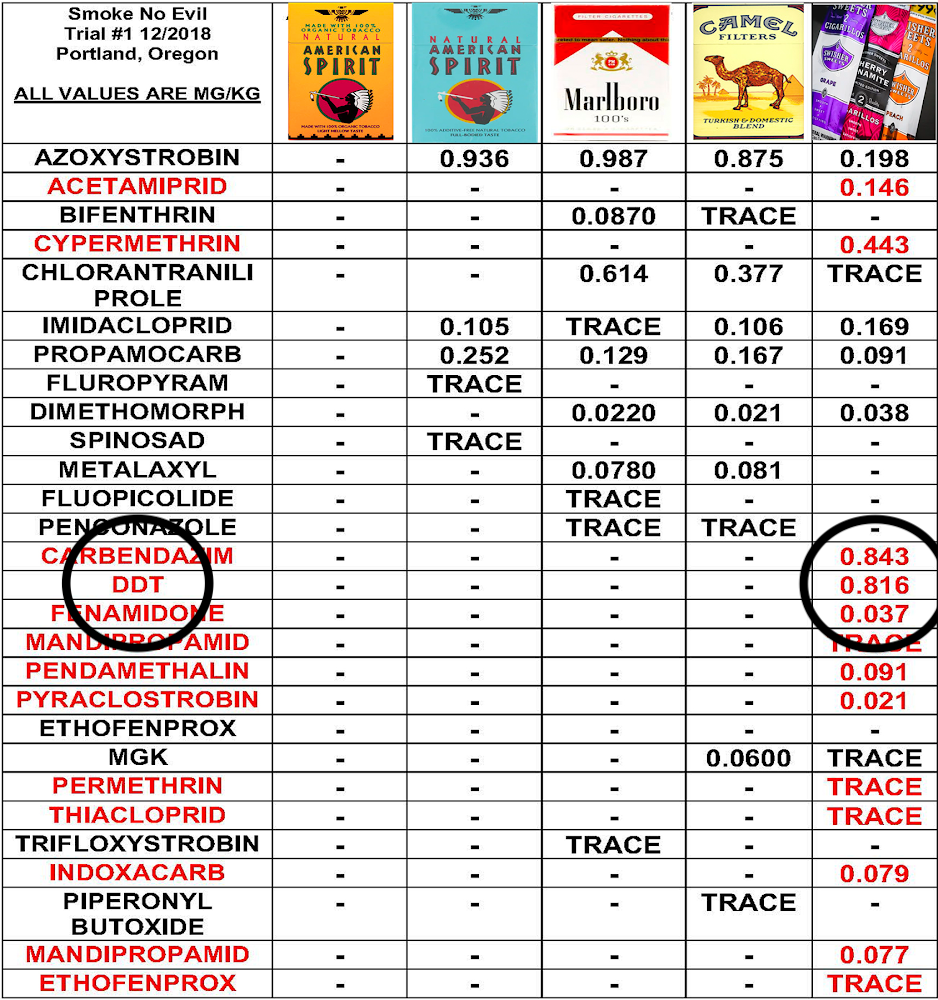Check the data below and I think you’ll agree that it looks like young people smoking Swisher Sweets, or rolling blunts with them, are seriously risking early-onset Parkinson’s. As you can see from the cited research, the pesticides DDT and Carbendazim that contaminate every Swisher Sweet are known to “cause selective degeneration of dopaminergic neurons” and are being inhaled with every puff and toke.
“Eleven Crucial Pesticides Appear to Regulate Key Genes That Link MPTP Mechanism to Cause Parkinson’s Disease through the Selective Degeneration of Dopamine Neurons” (Brain Science, 2023) https://www.ncbi.nlm.nih.gov/pmc/articles/PMC10377611/
“Pesticide exposures are a major contributing factor to PD. Several studies report that chronic pesticide/chemical exposure may cause and/or accelerate neurodegeneration. For instance, Langston JW et al. (2017) report that MPTP affects the nigrostriatal dopamine system, accelerates neuronal death [ 25]. Loss of dopaminergic neurons creates dopamine demand that diminishes neuronal connectivity and causes cardinal symptoms in PD [26–28]. Notably, most pesticides are highly lipophilic, easily cross the BBB, and accumulate in different brain regions. Subsequently, pesticides may use multiple neuronal
receptors for their internal cellular transport to disrupt neuronal function [ 11 ]. Pesticides may use multiple membrane receptors expressed by the neuronal types, but the mechanism leading to the selective loss of dopamine neurons in the substantia nigra of the human brain is largely unknown.“

As a point of reference, the average level of residual DDT found in 169 US food sources in the latest 2018-2020 FDA Total Diet Study was 0.0002 Mg/Kg. Compared that with the 0.816 Mg/Kg you see above. Every Swisher Sweets blunt will contain 4080 times the residual DDT in the food chain, and this heavy concentration must come from recent, direct DDT application to the tobacco in the field during production. Carbendazim and DDT are both banned worldwide, so what they are doing on tobacco products in the US is an open question.
“Overall, this study demonstrates the behavior of 11 critical pesticides that cause selective degeneration of dopaminergic neurons and that behave similarly to MPTP to cause Parkinson’s disease.”
Here are the 11 critical pesticides that cause selective degeneration of dopaminergic neurons, with their Pubchem IDs and connection with smokers & takers:
Benomyl (CID_28780)\
Carbendazim (CID_25429) (Currently contaminating Swisher Sweets)
S-methyl-N-butylthiocarbamate (CID_11137311) (Currently contaminating cigarettes)
Dichlorodiphenyltrichloroethane- DDT (CID_13089) (Currently contaminating Swisher Sweets)
Dichlorodiphenyldichloroethylene- DDD (CID_3035) (Contaminating cigarettes for decades)
Dieldrin (CID_969491) (Contaminating cigarettes for decades)
Heptachlor (CID_3589) Contaminating cigarettes for decades)
Heptachlor epoxide (CID_13930) (contaminated cigarettes in the 1960s-70s)
Lindane (CID_727) (contaminated cigarettes for decades)
Maneb (CID_3032581) (contaminated 1950s/60s cigarettes; currently contaminates many cigars)
Rotenone (CID_6758).
What Is MPTP, Whose Action These Pesticides Mimic?
https://www.sigmaaldrich.com/US/en/product/sigma/m0896
“1-Methyl-4-phenyl-1,2,3,6-tetrahydropyridine (MPTP) is a piperidine derivative and dopaminergic neurotoxin, useful in neurological research. MPTP is metabolized to 1-methyl-4-phenylpyridine (MPP+), which in turn can cause free radical production in vivo and lead to oxidative stress. Thus MPP+ is generally acknowledged as the active metabolite of MPTP. MPTP is widely used in in vivo research studies as a model for Parkinsonism. A review describes the application of MPTP in studies related to programmed cell death in neurogenerative diseases.”
There is a whole field of study involving Parkinson’s and pesticides, many of which are also known tobacco product contaminants; see also:
“A pesticide and iPSC dopaminergic neuron screen identifies and classifies Parkinson-relevant pesticides”
https://www.nature.com/articles/s41467-023-38215-z
The International Journal of Biochemistry & Cell Biology
https://pubmed.ncbi.nlm.nih.gov/15743669
“Dopaminergic neurons of the midbrain are the main source of dopamine (DA) in the mammalian central nervous system. Their loss is associated with one of the most prominent human neurological disorders, Parkinson’s disease (PD).. Although their numbers are few, these dopaminergic neurons play an important role in the control of multiple brain functions including voluntary movement and a broad array of behavioral processes such as mood, reward, addiction, and stress.”
And then …
Environmental neurotoxicant-induced dopaminergic neurodegeneration: a potential link to impaired neuroinflammatory mechanisms
https://www.ncbi.nlm.nih.gov/pmc/articles/PMC6520143
“Indeed, a definite causality has been identified between pesticide exposure and mitochondrial dysfunction.“
So, if the relationship between pesticides, Parkinson’s and tobacco products makes sense and looks probable or at least possible, you’ll probably also want to check out the possible Alzheimer’s connection. Same story – zero government regulation and massive exposure of young smokers and tokers.

Hi Bill,
Thanks for keeping us informed about the hidden dangers of conventional tobacco. I personally encourage people to grow their own. It is relatively easy to grow and cure tobacco, although like anything its easy when you know how and somewhat daunting to get started. My new book “Growing Plant Medicine Vol 2” covers tobacco under the nightshade family chapter. You can check our organic tobacco seed at http://www.strictlymedicinalseeds.com
Meanwhile, thanks for keeping on educating and watch out for those swisher sweets. . . honestly they never were a good idea.
Your friend,
Richo
LikeLike
Hi Richo – thanks for your generous comment and I second your suggestion that people grow their own everything! Cheers Bill
LikeLike